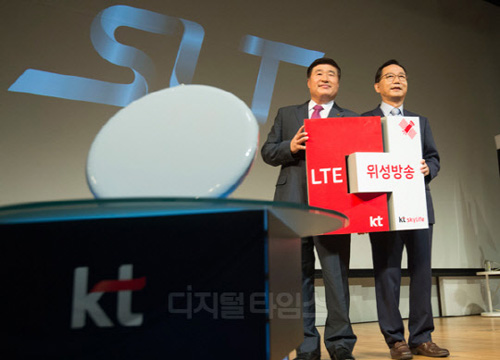KTㆍSkylife-the first LET TV in the world…Seamless satellite TV in heavy rain & tunnel
Na Won Jae | nwj@ | 2017-07-13 10:54:50

KT and KT Skylife revealed the launch of 'SKYLIFE LONG TIM EVOLUTION (LTE) TV' at Gwanghwamun building in Seoul on July 12, and it will show the world the first hybrid media service that can enjoy continuous high-definition broadcasting on the go. At the event, KT Mass, General Manager of the company (left) and KT Skylife CEO Lee Nam, are announcing the launch of LTE satellite broadcasting service. By Yoo Dong Il eddieyou@
High-quality real-time video can be viewed seamlessly in cars and buses passing through heavy rain or tunnels.
KT and KT Skylife introduced `Skylife Long Term Evolution (LTE) TV` (SLT) for the first time in the world.
The two companies revealed that they will penetrate the domestic mobile media service market, which is estimated to be more than 1.3 million people with SLT technology, and will advance into the autonomous vehicle market in the future.
The two companies predicted that when the age of autonomous cars based on the 5th generation (G) network comes, the number of people enjoying dramas and movies during driving will surge, and the market for mobile media services will also change drastically.
SLT is a service that provides high-definition video regardless of driving situation by combining KT`s LTE technology with KT Skylife satellite broadcasting. Providing real-time broadcasting by satellite in the case of a satellite signal becomes weak due to heavy rain or entering a tunnel, it provides real-time broadcasting signal through LTE.
SLT has a technology called `B.U.S.` `B.U.S.` is abbreviation of buffering, unified intelligent LTE switching, and still cut.
Buffering is a technology that plays back satellite signals received in real time after delaying about 5 seconds in a set-top box. When entering or leaving a shadow area such as a tunnel, it helps to prevent the video from being interrupted during the transition from satellite network to LTE network.
Integrated intelligent LTE switching is a technology that changes the reception of broadcast signals from satellite to LTE in about one second when the satellite signal is bad, and changes the receiving method from LTE to satellite once the satellite signal gets better. SteelCut is a technology that exposes the last scene of broadcasting that was already being watched so that the screen continues smoothly even when the reception method between satellite and LTE changes.
The two companies completed 7 months of test service on major expressways nationwide prior to the launch of the SLT, including Gyeongbu, Chungbu and Yeongdong for two months from May.
Besides, the companies said they plan to apply RET (retransmission) technology to overcome the temporary loss of broadcast data packets by the end of this year. RET analyzes the screen information stored in the set-top box for 5 seconds, and transmits the broken image information from the broadcasting center to the LTE network to provide a clean screen when the screen is broken.
The two companies are also expected to upgrade satellite antennas with the launch of the SLT, and by the end of the year, they will show ultra-slim SLT antennas (25 x 30 cm).
SLT provides more than 40 real-time channels of various genres such as drama, film, sports, as well as terrestrial and continental pieces. New subscribers will receive three months free service and installation discounts by September this year. The two companies will launch additional high-end products that add video-on-demand (VOD) services to real-time channels in November.
By Na Won Jae nwj@
